Use 'Print preview' to check the number of pages and printer settings.
Print functionality varies between browsers.
Printable page generated Thursday, 20 November 2025, 12:44 AM
Health Management, Ethics and Research Module: 4. Implementing your Health Plans
Study Session 4 Implementing your Health Plans
Introduction
In the previous study session you learned how to plan health programmes in your community. This study session builds on that knowledge.
Implementation is a central part of healthcare management. It is the stage where you translate planned activities into action, using key concepts to help you determine how best to use your group activities and resources, and motivate members of your team to work in the best interests of the health of the community.
In this study session you will be briefed and equipped with the concepts and skills that will help you to learn how you can organise the volunteers, model family members and others in your community. You won’t be able to improve the health of your community on your own, but it will be possible to do this by directing and building a team, then leading, motivating and training them.
You will learn how to translate a healthcare plan into activities that you can implement in your own community. In order to do this you need basic skills and knowledge on getting organised, setting up activities, finding resources, building a team, and leading, motivating and training that team. Later in the study session you will be introduced to the importance of conducting meetings and some useful skills for the management of meetings.
During this study session you will be able to learn how to put into place, or implement, your planned healthcare activities.
Learning Outcomes for Study Session 4
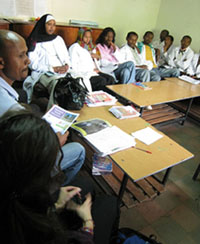
When you have studied this session, you should be able to:
4.1 Define and use correctly all of the key words printed in bold. (SAQs 4.1 and 4.2)
4.2 Discuss how to implement a health management plan by organising relevant activities and resources. (SAQ 4.2)
4.3 Describe team building concepts and stages so that you can effectively implement your health management plan. (SAQ 4.4)
4.4 Explain how to lead and motivate team members such as volunteers, primary healthcare workers and model families. (SAQ 4.5)
4.5 Briefly describe the importance and procedures of health-related meetings. (SAQ 4.3)
4.1 Getting organised
As you might expect, getting organised is the first stage in bringing together the right combination of human, physical and financial resources to successfully undertake your planned activities. Your health plan will require the involvement of different members of your community to make up a team and you will also need a variety of other resources (Figure 4.1). As the Ethiopian proverb says, ‘When spiders’ webs unite, they can tie up a lion.’
You will find that organising activities or groups of activities involves planning all your activities in order to avoid any duplication of jobs. For instance, if activities are not properly arranged, two or more people may end up doing the same job at the same time.
Box 4.1 Getting organised
Organising is the means by which:
- the right things are done (what)
- in the right place (where)
- at the right time (when)
- in the right way (how)
- by the right people (by whom).
Look closely at Box 4.1. How else could you describe getting organised?
The box shows that organising is the means of distributing authority, providing channels of communication and arranging the work in order to achieve the correct outcome.
One of a Health Extension Practitioner’s most important functions when working in the community is the distribution of tasks among the members of their health team. Work should be arranged in such a way that team members make best use of their individual skills and talents. It is important to distribute work fairly. You may need to prepare a checklist which describes tasks among the health team. The checklist can state the objectives, activities and responsibility of each person.
Case Study 4.1 Allocating tasks to the health team
As the Health Extension Practitioner in your Health Post you have planned to conduct an immunization day. You have groups of community members to assist you, such as volunteers and health promoters, as well as you and your team in the Health Post.
Your first role is to identify all the activities which have to be performed and you will have to assign duties to your team of Health Extension Workers, volunteers, model household members and so on. You may need to group the tasks in such a way that you form committees or teams for particular activities.
The first team could do community mobilisation and awareness creation work; the second team could work on the practical arrangements of the immunization day; a third team could carry out the actual immunization activity.
Your next role is to select a team leader for each team. The role of the team leader is to coordinate the team members and also to communicate with you on the activities that the team is carrying out. Depending on the situation the team leader may also be responsible for finances.
Your final step is to allocate the resources (time, money, people, space and equipment) needed by each team. In summary, by being well organised you will be able to implement what you have planned (Figure 4.2).
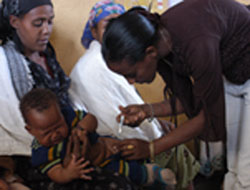
What is the objective of the activity to be carried out in the case study?
To mobilise members of the community to participate in the immunization day and particularly to bring their children for vaccination.
You can use the checklist in Box 4.2 to help you when organising your health teams.
Box 4.2 Organising your team
Organising activities:
- What is to be done?
- Where will the action take place?
- When will the action take place?
- What equipment is needed?
- How will the activity be arranged?
Organising people:
- Which members of the health team will be involved?
- Who outside the health team will be involved?
- Who will do what?
- Who will lead?
Communicating:
- Is all necessary information available?
- Has the information been communicated?
Look back carefully at Box 4.2. Which of these activities is the most important to make sure that your team is organised to take part in health activities?
The whole point of organising your activities in this way is that all of these activities are equally important. Unless all these activities are undertaken your plan will not be implemented because people won’t know what to do, or how to do it.
4.2 Building a team
Health Extension Practitioners work with a variety of community groups and your job will often require you to create health teams from your community in order to achieve community health goals. In this section you will consider why team building is important, the different kinds of teams, and the ways that teams can come together to get their work done.
A team is two or more people who work together to achieve a common goal. A health team is a group of people who share common objectives, determined by community need. Each member of the team contributes to the achievement of the common goal.
Your health team members include, for example, health promoters, model households, opinion and political leaders, and various community association members. It is always important that their work and contributions are recognised.
4.2.1 Types of health team
In Primary Health Care management you will find that teams work best when they involve those people who are closest to the community in making decisions that are important for their community. Because teams like this include the most appropriate community members, the team will have the authority it needs to achieve its aims (Figure 4.3).
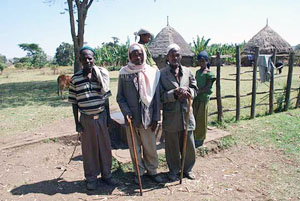
Formal teams are teams assembled to address a specific problem or issue, or to achieve specific health goals. An example of a formal team is a task force or committee.
A committee is usually a small, deliberately assembled group of people who are organised to consider and take decisions about a specific set of issues. These can be long-term or permanent teams designed to perform ongoing, specific organisational tasks. For example, as a Health Extension Practitioner you might form a committee composed of a model household representative, a kebele leader, a religious leader and representatives of community-based associations, such as a youth or women’s group.
The members of a health team should work closely with workers from other sectors concerned with community health, such as teachers, agriculture extension workers, community devolvement workers and religious leaders (Figure 4.4).
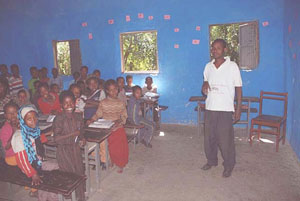
4.2.2 Stages of team building
Team building usually refers to the process of selecting and creating a team within a community. To improve the performance of any health teams that you are keen to develop it is helpful to use the structured four-stage team building model described below.
Forming
The first stage in team development is the forming stage. During this stage your health team members get to know each other and find out which behaviours will be acceptable to the rest of the group members. Members establish initial rules and ways of working with each other. This exercise helps the team to create trust among team members.
Storming
During the storming stage, team members are encouraged to participate and engage with the issues and decisions that are key to the success of the community health team in achieving its goals. This is the stage when health team members may challenge, disagree with, and question one another. This stage can be uncomfortable for some members, but it is an important stage in tackling problems.
Norming
At this stage the team comes to an agreement on its purpose and plans. Members are clear what their roles and responsibilities are and how they fit into the team. The team has a sense of identity and tries to work together. By the time the team reaches this stage they know how to work with each other.
Performing
Group structure, norms and behaviour are understood and accepted. Members know how to work with each other and can effectively handle disagreements and misunderstandings. Differences have minimised and members have dealt with them. The group is now focused on accomplishing its purpose.
Look at Table 4.1 to see a detailed checklist of what to do at each stage of team building.
| Stage of team building | Member issues | Team tasks | Team behaviour |
|---|---|---|---|
| Forming | Who are these people? | Identify member skills, talents, behavioural preferences | Develop trust |
| How do you relate to them and they to you? | Establish base level expectations and operating ground rules | Bonding | |
| Are you in or out? | Establish common goals Establish roles | Greater bonding | |
| Storming | Who’s in control here? | Develop communication skills | Expressing different ideas, feelings and opinions |
| How will the rules really work ? | Test ground rules | Responding to leadership and followership | |
| Are you up or down ? | Clarify roles, goals and resources in and outside the team Power and control issues | Becoming dependent on each other | |
| Norming | How are we doing? | Utilise the ground rules and hold people accountable | Checking with members to assure understanding |
| Are we all clear about what we each bring to the team? | Continue to clarify goals | Clarifying, gatekeeping, encouraging participation and honesty | |
| Are we able to work effectively with each other? | Processes for decision making and problem solving | Comfortable with differences of opinion or style | |
| Performing | I know my value to this team | Achieve tasks efficiently | Use each other as sounding boards |
| We need each others’ expertise | Exercise effective communication, problem solving and decision making skill | Rotate leadership and fellowship | |
| We are a cohesive group | Give and receive performance and personal feedback effectively Share power and control | Demonstrate caring collaboration and independence |
Case Study 4.2 Four stages of team building
You are assigned to a rural village and as part of your work you are planning to establish a health team who can work with you to achieve the goal of improving the health of everybody in the community. You have already identified the members of your health team and need to start building your team. You want to apply the four stages of team building so that you will have an effective team.
As a Health Extension Practitioner selecting and creating this team within your community, what are the steps that you would follow to build a strong team?
First, form a team by identifying community members who are well informed about health issues. They are interested in participating in the community health work, and are willing to become volunteers (the forming stage). After you have identified them, try to build trust and set ground rules and common goals for why you are coming together. Secondly, in the storming step, you may want to call a meeting and let everyone express their ideas, feelings and opinions. Do not worry if you find that people hold different views at this stage. Thirdly, in the norming stage, every team member should try to understand each other, as they go about decision making about health issues in the community. Fourthly, during the performing stage, the team should be able to go about the required work and demonstrate collaboration and independence.
4.3 Leading a team
Leading is the management function that you will use when influencing, motivating and directing people in your team towards the achievement of your organisational goals. All teams benefit from direction and as a leader you must deal with and motivate the people you work with in your health teams.
You have studied the concept of leadership in Study Session 2. What critical role do leaders play in healthcare management?
Leaders in primary healthcare management give a direction for the community about health issues. They help them see what lies ahead and help them visualise what they might achieve; they encourage and inspire all the community members
4.3.1 Different styles of leading a team
There are three main styles of leading a team: autocratic, anarchic and democratic. Box 4.3 shows some characteristics of each of these styles.
Box 4.3 Styles of leadership
Autocratic: ‘Do what I say’
Anarchic: ‘Do what you like’
Democratic: ‘Let us agree on what we are to do’
Autocratic leaders tend to be dictatorial, saying for example ‘Do what you are told, and don’t ask questions!’ Anarchic leaders tend to say things like, ‘I don’t care what you do, so long as you keep out of my way!’ Democratic leaders are consultative and take advice from their team, saying things such as, ‘These are the goals we have to achieve. Let us agree how best to work together.’
Think about the leadership style that might be most effective when working with health teams in your community. Which style do you think it would be best to adopt?
A consultative or democratic style is most suitable for any team work that demands creativity and community involvement. Effective Health Extension Practitioners have a democratic style and help to build teams that are happy and hard working.
4.4 Motivating a team
As most of your team members are likely to be unpaid volunteers, motivation of team members is going to play an important role in the success of any health plan for your community. When each team member feels important to the team and trusts the team they will bring their best skills to the group. This will boost the team and motivate its members to succeed (Figure 4.5).
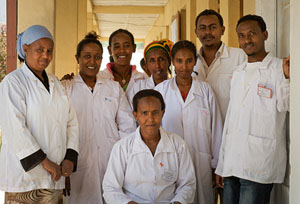
In Box 4.4 you will find a checklist of some effective methods you can use to keep your team motivated.
Box 4.4 Keeping your team motivated
- Take the time to meet with and listen to team members.
- Provide teams with specific and frequent feedback about their performance, and support them in improving their performance.
- Recognise, reward and promote high performance; deal quickly with poor performance so that they can improve and learn from mistakes.
- Provide information on how the organisation has achieved or failed to achieve the community health goals.
- Involve teams in decisions, especially those decisions that affect them.
- Give members of the team the opportunity to grow and develop new skills.
- Provide team members with a sense of ownership in their work and their working environment.
- Strive to create a work environment that is open, trusting and fun.
- Encourage new ideas, suggestions and initiatives.
- Celebrate individuals’ successes and take time for morale building team meetings and activities.
- Personally thank team members for doing a good job.
Look through the list of motivational ideas in Box 4.4. Which of these methods do you think will be the most difficult to achieve?
Lots of these ideas are actually interconnected. If the entire team works in a good atmosphere and is used to giving help and support to all its team members then most of these motivational ideas will become routine and the team should go from strength to strength.
4.5 Training your team
Training a local health team is one of the Health Extension Practitioner’s responsibilities. The Health Extension Programme uses community member training as a means of making the best use of people in the community. The quality of healthcare and its equitable distribution in a population depends upon the staff employed by the health services, and upon community members trained with some knowledge and skills of health.
A team leader uses training to make sure that each member of the team can play their part in achieving their goals, both as an individual and with other members of the team. Training as a means of solving health problems must be closely related to work in the field, and to the management of priority health problems.
Why do you think it is important to provide training for members of your team?
To make sure that each member of a team knows and can play their part in achieving the goals of the health system. This can be difficult to do but with practice you will be able to provide interesting and effective training for your team.
4.6 Conducting meetings
Meetings are a necessary part of the Health Extension Programme because meetings are the way in which health teams communicate with people in their locality (Figure 4.6).
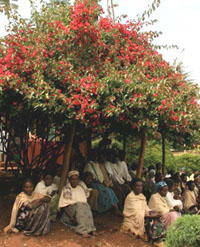
In the delivery of health services to the community you may be able to use a variety of different types of meetings:
- Large public meetings, often held in the open air, to encourage people to express their views on a community health problem or to inform and explain something new to the community.
- Small meetings often held with community leaders to identify health problems and needs.
- Meetings with special groups, such as young people or mothers, for the specific purposes of health education.
- Regular meetings of the health team.
- Committee meetings, which may be important in making decisions about new ideas.
- Discussion groups to learn new skills, techniques and approaches.
Box 4.5 Planning your meetings
When preparing for a meeting it is useful to plan the following:
- purpose of meeting
- main subject matter
- type of meeting
- size of meeting
- place, time and duration of meeting
- who is convening and organising the meeting
- announcement or information about the meeting.
Look carefully at Box 4.5. Imagine that you want to hold a meeting to tell local mothers about their contraceptive choices. What planning would you do before the meeting started?
The more planning that you do before the meeting the more likely it is to run smoothly. You certainly need to cover all the points in this box and be sure that all these items are clear in your mind.
4.6.1 Purpose
Some meetings are called to communicate information, others to exchange views and ideas, and others to make decisions about plans or activities (Figure 4.7).
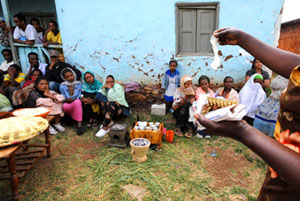
In all cases, the purpose of the meeting should be made clear. For a formal committee, the agenda should state the purpose. However, it is worth writing a brief summary of the purpose, stating what it is hoped to achieve.
4.6.2 Have an agenda
If a meeting is to be useful, each person present must have as much information as possible about the agenda to be discussed. Distribute the agenda to participants before the meeting so participants can be prepared for the meeting. If this is not possible then spend a few minutes at the start of the meeting creating the agenda and taking suggestions from the people who are present.
4.6.3 Start on time and end on time
Every meeting should have established start and end times. Be sure to start your meetings at the appointed time and run no longer than the end time. You may want to estimate a period of time for each agenda item so that all agenda items can be covered in the time available.
4.6.4 Maintain focus
Stay on topic and avoid the temptation to get diverted by interesting but unproductive points of view. Stick to the topic and the timelines you set for each item on the agenda.
4.6.5 Capture action points
Have a system for capturing, summarising and assigning action points to individual team members. This can often be handled by assigning specific roles to people who are at the meeting, such as timekeeper and reporter. Check on progress at the next meeting.
4.6.6 Get feedback
Get feedback on your meeting management. Remember that feedback tells you not only what you did right but also what you did wrong, providing you with ideas on how to make your future meetings more effective.
Summary of Study Session 4
In Study Session 4, you have learned that:
- Getting organised involves bringing together the right combination of human, physical and financial resources to successfully undertake planned health activities to achieve a common goal.
- Building a team usually goes through four stages: forming, storming, norming and performing.
- Motivation encourages health teams to participate and produce good results. There are a number of different mechanisms for motivating teams.
- Training is used by health managers to make sure that local people are equipped to deliver health services at the community level.
- Running effective meetings will help you to achieve your health goals.
Self-Assessment Questions (SAQs) for Study Session 4
Now that you have completed this study session, you can assess how well you have achieved its Learning Outcomes by answering the following questions. Write your answers in your Study Diary and discuss them with your Tutor at the next Study Support Meeting. You can check your answers with the Notes on the Self-Assessment Questions at the end of this Module.
SAQ 4.1 (tests Learning Outcome 4.1)
What do you understand by the term ‘implementation’? Say why it is important in the work of a Health Extension Practitioner.
Why do you think that Health Extension Practitioners should be involved in leading their communities in health matters?
Answer
Implementation takes place when you put into action the various steps that are needed to make sure that your health goals are met. Just having plans and goals won’t improve the health of your community. You have to implement your plans and make sure they happen. Implementation will require leadership. Health Extension Practitioners know about the health issues that affect their communities and their leadership is important in implementing the plans that will improve the health of their community.
SAQ 4.2 (tests Learning Outcomes 4.1 and 4.2)
Imagine you are planning a project to test school students for HIV. How would you implement this health plan? Fill in the grid below to help you plan the things your team should do to help you in this task.
| Organising your team | HIV testing project |
|---|---|
| What is to be done? | |
| Where will the action take place? | |
| When will the action take place? | |
| What equipment is needed? | |
| How will the activity be arranged? | |
| Which members of the health team will be involved? | |
| Who outside the health team will be involved? | |
| Who will do what? | |
| Who will lead? | |
| Is all the necessary information available? | |
| Has the information been communicated? |
Answer
To undertake health activities in your community you will need to get organised and develop a team to help you. This may be a formal team such as a committee of students and young people. You will have to make sure that you lead the team and help them understand what they have to do, when they have to do it and who to report to about their actions.
| Organising your team | HIV testing project |
|---|---|
| What is to be done? | Get as many students as possible to attend for HIV testing |
| Where will the action take place? | In each school |
| When will the action take place? | At the beginning of the day during week 4 of term (or other specified time) |
| What equipment is needed? | We will need sufficient testing kits |
| How will the activity be arranged? | A room will be booked where there is some privacy |
| Which members of the health team will be involved? | Volunteer counsellors and the Health Extension Practitioners |
| Who outside the health team will be involved? | Teachers must also be included |
| Who will do what? | Teachers will be trained to support the students and encourage them to attend |
| Who will lead? | Health Extension Practitioners |
| Is all the necessary information available? | Get health education material and posters |
| Has the information been communicated? | Make sure posters are in place for a week before the testing activity is due to start |
SAQ 4.3 (tests Learning Outcome 4.5)
Using the grid below, describe how you would plan a meeting to discuss latrine use in your village.
| Purpose of meeting | |
| Main subject matter | |
| Type of meeting | |
| Size of meeting | |
| Place, time and duration of meeting | |
| Who is organising the meeting? | |
| Information about the meeting |
Answer
Your answer may be slightly different from this example.
| Purpose of meeting | To discuss with village leaders how to increase latrine use |
| Main subject matter | Latrine use and latrine building |
| Type of meeting | Committee meeting |
| Size of meeting | Ten people maximum |
| Place, time and duration of meeting | Afternoon when people have stopped work in the fields |
| Who is organising the meeting? | Health Extension Practitioners |
| Information about the meeting | Make sure all the right people are invited and know when to attend |
SAQ 4.4 (tests Learning Outcome 4.3)
What are the main stages of team building? How do you think knowledge of these stages will help you develop the teams to help you implement your health plans?
Answer
The main stages are usually considered to be forming, storming, norming and performing. Knowledge of these stages will help you build the teams that will help you meet your health goals. If you know about these stages you will be able to plan how the teams work at various stages in their development. For example, understanding that it is common for team members to disagree at the start, but they will move towards agreement by the end, will stop you worrying unnecessarily.
SAQ 4.5 (tests Learning Outcome 4.4)
Imagine you were trying to run a health club in a school in your village. How would you motivate the health team involved? It might help you to look at the list of motivational methods in Box 4.4.
Answer
To motivate the health team, you would need to:
- Take the time to meet with and listen to teachers and school students about the health club.
- Make sure that you provide the health club team with lots of feedback about how their club is doing.
- Provide relevant information about how the health club is helping to achieve the community health goals.
- Make sure the health club is always open, trusting and fun.
- Encourage new ideas, suggestions and initiatives.
- Personally thank team members for doing a good job.